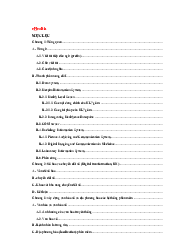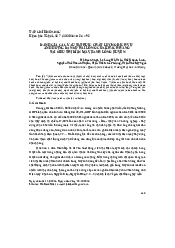



























































































































Preview text:
THE EFFECT OF CUSTOMER PERCEPTION TOWARDS ELECTRONIC BRICK-
AND-CLICK RETAILERS IN DURBAN, KWAZULU-NATAL BY Makhosazane Buthelezi
Student number: 21224782
Submitted in fulfilment of the requirements for the degree:
Master of Management Sciences: Retail Business Management
Durban University of Technology
Faculty of Management Sciences
Department of Marketing and Retail Management
APPROVED FOR FINAL SUBMISSION
______________________ _________
Supervisor: Dr. P. Moodley Date Page | i DECLARATION
I, the undersigned, Makhosazane Buthelezi, do hereby declare that unless otherwise
indicated, this dissertation is solely the result of my own work. This work has not
been submitted to any other tertiary institution for a degree award or other purposes
and all the authors whose work contributed to this study have been accordingly referenced.
___________________ ___________ Signed Date Makhosazane Buthelezi Page | ii DEDICATION
This work is dedicated to my magnificent God, the master of the universe and the
ruler of the heavens and the earth who made it possible for me to undertake and
successfully complete this study. Page | iii ACKNOWLEDGEMENTS
This dissertation would not have been possible without the support and dedication of
a number of very special persons. Thank you to:
My Creator for the talent, the knowledge, the determination and the
strength to complete this study.
My Supervisor Dr P. Moodley for her continued support,
encouragement and long hours of reading this study, of which I am proud.
Extend my special gratitude to Erica Fouche for granting me the
permission to conduct my survey.
Mr. Jacques Cloete for assistance on the technical side.
All my friends and family members for their patience and unending support. Page | iv ABSTRACT
Brick-and-Click retailing was introduced in the 21st century and it was a challenge to
traditional retailers (Diamond and Pintel 2013: 91). Kloppers (2014: 1187) reveal that
online shopping has grown tremendously worldwide in the last few years but South
Africa seems to lag behind the rest of the world where the development of Brick-and-
Click is concerned. Gupta, Mittal and Nayyar (2011: 401) state that electronic
retailing is now a trending shopping tool. Laudon and Traver (2010: 6) assert that as
electronic retailing drastically grows, most customers act and react based on their
perceptions, not objective reality. According to Hawkins and Mothersbaugh (2010:
278) customer9s perception are much more vital than their knowledge of objective
reality. Customer9s perception affects their actions, leisure and buying habits which
has a great impact on the Brick-and-Click retailers. Laudon and Traver (2010: 5)
believe that electronic retailing is challenging to most retailers, as there are many
factors that need to always be considered. Botha et .
al , (2008: 277) mention that the
South African online retail market needs to overcome a number of obstacles in order
to enhance the growth of online shopping.
The aim of this study is to identify the factors that affect customer perception on
electronic retailing in Brick-and-Click retailers in Durban, KwaZulu-Natal. The
primary objective of the research is to examine the effect of customer perception of
electronic retailing in Durban. Durban is known as the largest city in KwaZulu-Natal,
therefore using Durban as the sample was advantageous to the study in terms of
results. Furthermore, this study obtained permission (see appendix C-gatekeepers
letter) from Mr Price Clothing who is one of the largest retailers in Durban to engage in this study.
The study followed a quantitative research method in order to attain the set
objectives of the study. Non-probability sampling technique was employed in
recruiting the participants. Convenience and purposive sampling techniques were
used to generate the sample population in this study. The target population for the
study were all the customers that shop at the Brick-and-Click retailers in Durban,
KwaZulu-Natal. Questionnaires were administered electronically via the database of
Mr Price. The study used both descriptive and inferential statistics. Statistical
Package for Social Scientists (SPSS) version 23.0 was used to analyse the data. Page | v
The results suggest that Brick-and-Click retailers pay more attention towards the
factors that affect the customer perception as they can determine the success or
failure of the business. Researchers in the literature review highlight that customer
perception is the way customers view shopping quality of the stores performance
and effectiveness in terms of its product or services (Ha and Stoel 2011: 199).
Aspfors (2010: 10) believes that it is essential to identify customer9s needs and
wants by knowing customer perceptions. The study revealed that majority of
customers indicated that they are aware of electronic retailing, a frequency of 2-3
times a month was the highest followed by never shopped online customers. The
study also discovered that customers were influenced by different factors to shop
online, less are of the opinion that online shopping is secure, and even fewer are
prepared to make online payments. Finally, only few have a positive attitude toward
online shopping. Lastly, the study also discovered that prices and delivery are the
main motivating factors for customers to shop online while the least motivators were
referrals from friends, family and review site, company reputation and appealing product description.
Lee and Barnes (2016: 48) suggest that Brick-and-Click retailers invest in Research
and development (R&D) to discover various factors affecting the customers to buy
electronically. Brick-and-Click retailers are further advised to develop strategies
pertaining how to retain customers especially strategies suitable for their target
market as they all differ from one retailer to another. Research and development can
assist in implementing the right strategies at the right time minimizing cost. Through
research and development, the retailer can also determine the needs and wants
through understanding perception of customers. Retailers must be aware of all the
factors in order to provide ideal strategies. Recommendations on how to use the
important factors in online shopping could be aimed at developers of websites and
owners of Brick-and-Clicks. They should change their marketing strategies giving
priority to customer orientation and they should be particularly focused on the ease
of use of online shopping services. Brick-and-Click retailers should devote resources
to better understand consumer behaviour, technologies of the future and their
development (Baubonienė and Gulevičiūtė 2014:81). Page | vi TABLE OF CONTENTS
The influence of customer perception towards electronic retailing at brick-and-click
retailers in Durban, KwaZulu-Natal
CHAPTER ONE: INTRODUCTION OF THE STUDY 1.1 Introduction 1
1.2 Background of the study 1
1.3 Statement of the research problem 2 1.4 Aim and objectives 3 1.4.1 Aim of the study 3 1.4.2 Objectives of the study 3 1.4.3 Research questions 3
1.5 Rationale of the study 4 1.6 Scope of the study 4 1.7 Delimitations 4 1.8 Limitations 5
1.9 Theoretical background 5
1.10 Research methodology 6
1.11 Outline of the dissertation chapters 6 1.12 Conclusion 8
CHAPTER TWO: LITERATURE REVIEW 2.1 Introduction 9
2.2 Definition of key terms 9 2.2.1 Electronic retailing 9 2.2.2 Brick-and-Click 9 Page | vii 2.2.3 Customer perception 10
2.3 Electronic retailing 10
2.3.1 Electronic retailing in South Africa 11
2.3.2 Customer acceptance of electronic retailing 12
2.3.3 The purpose of electronic retailing 14
2.3.4 The importance of electronic retailing 15
2.3.5 Advantages of electronic retailing 15
2.3.6 Disadvantages of electronic retailing 16
2.4 Customer perception towards electronic retailing 18 2.5 Proposed model 19
2.5.1 The customer perception process 20
2.6 The importance of understanding customer perception in retailing 24
2.7 Factors influencing customer perception towards electronic retailing 25
2.7.1 Transactions or payment systems 26 2.7.2 Trust 27 2.7.3 Fraud 27 2.7.4 Returns 28 2.7.5 Late deliveries 28
2.7.6 Electronic Word-of-Mouth 29
2.8 The influence of customer perception on electronic retailing 30
2.9 Consumer buying behaviour towards electronic retailing 31
2.9.1 Relationship between customer perception and customer buying behaviour 31
2.9.2 Customer mind-set in online shopping 32 2.9.3 Consumer buying process 32
2.10 Online customer experience 35 2.11 Expectations 36 Page | viii 2.11.1 Levels of expectations 36
2.11.2 Types of online expectation 37 2.12 E-satisfaction 38 2.13 E-loyalty 39
2.13.1 The three advantages of e-loyalty 39
2.14 Strategies used to develop customer base 40
2.14.1 Electronic Customer Relationship Management 40
2.14.2 Introduce E-SERVQUAL method 41
2.14.3 Benefits to the e-retailer for using E-SERVQUAL method 42 2.14.4 Portfolio matrix 43 2.15 Conclusion 45
CHAPTER THREE: RESEARCH METHODOLOGY 3.1 Introduction 47
3.2 Research objectives 47 3.3 Research design 47 3.4 Study approach 48 3.5 Target population 50 3.6 Sampling method 50
3.7 Sample selection and size 50
3.8 Research instrument 51 3.8.1 Measuring instrument 51
3.8.2 Development of the questionnaire 51 3.8.3 Questionnaire design 51
3.8.4 Structure of the questionnaire 52 3.9 Data collection 52 Page | ix 3.9.1 Informed consent 53 3.9.2 Pre-test 53 3.9.3 Data analysis 53 3.9.4 Validity 54 3.9.5 Reliability 54
3.10 Ethical considerations 54
3.11 Anonymity and confidentiality 55
3.12 Limitations of the study 55
3.13 Delimitations of the study 55 3.14 Conclusion 56
CHAPTER FOUR: DATA ANALYSIS 4.1 Introduction 57
4.2 Response rate of the study 57
4.3 Research instrument 58 4.4 Frequencies 58 4.4.1 Gender of respondents 59 4.4.2 Race of respondents 60 4.4.3 Age of respondents 61
4.4.4 Employment of respondents 62
4.4.5 Monthly income of respondents 63
4.4.6 Educational level of respondents 64
4.4.7 Frequency of respondents shopping online 67
4.4.8 Factors affecting respondents who do not shop online 73
4.4.9 Opinion of the respondents who do not shop online 73 4.5 Conclusion 79 Page | x CHAPTER FIVE 5.1 Introduction 80
5.2 Review of the theoretical study 80 5.3 Empirical study 80
5.4 Aim and objectives of the study 81 5.4.1 Aim 81 5.4.2 Objectives 81
5.5 Findings from the study 81 5.5.1 Objective one 81 5.5.2 Objective two 82 5.5.3 Objective three 83 5.5.4 Objective four 83 5.6 Conclusions 83
5.7 Limitations of the study 84
5.8 General recommendations 84
5.9 Specific recommendations 85
5.9.1 Manage customer perceptions 85
5.9.2 Invest more in marketing and promotions to attract and retain current Customers 85 5.9.3 Create loyalty programs 86
5.9.4 Implement advanced technology system 86
5.9.4 Provide a secure and easy payment processing 86
5.10 Recommendations for further research 87 5.10 Conclusion 88 Page | xi List of reference 89 Appendix A 104 Appendix B 110 Appendix C 111 FIGURES
Figure 1.1: Outline of the dissertation chapters 7
Figure 2.1: South African electronic retail sales 2004-2011 11
Figure 2.2: Growth of electronic retailing per country 12
Figure 2.3: Technology acceptance model 13
Figure 2.4: Customer perception process 20
Figure 2.5: Proposed model of customer perception process 21
Figure 2.6: The power of word-of-mouth 30
Figure 2.7: Consumer buying behaviour process 34
Figure 2.8: Factors that affect e-satisfaction 38
Figure 2.9: The four different sections within the BCG Matrix 44
Figure 4.1 Gender of respondents 60
Figure 4.2 Race of respondents 61 Figure 4.3 Age of respondents 61
Figure 4.4: Employment of respondents 62
Figure 4.5: Monthly income of respondents 63
Figure 4.6: Educational level of respondents 64
Figure 4.7: Frequency of respondents who do not shop online 68
Figure 4.8: Factors affecting respondents who do not shop online 73
Figure 4.9: Opinion of the respondents who do not shop online 74 Page | xii TABLES
Table 3.1: Characteristics of quantitative approach 49
Table 4.1: Response rate of the survey 57
Table 4.2: Questionnaire setting 58
Table 4.3: Respondents of online and non-shoppers 59
Table 4.4: Gender of respondents cross tabulated with shopping 60
Table 4.5: Demographics of adopters and non-adopters 65
Table 4.6: Demographics frequency of respondents 69
Table 4.7: Respondents motivating factors to shop online 77
Table 4.8: Perception of respondents who shop online 78 Page | xiii



